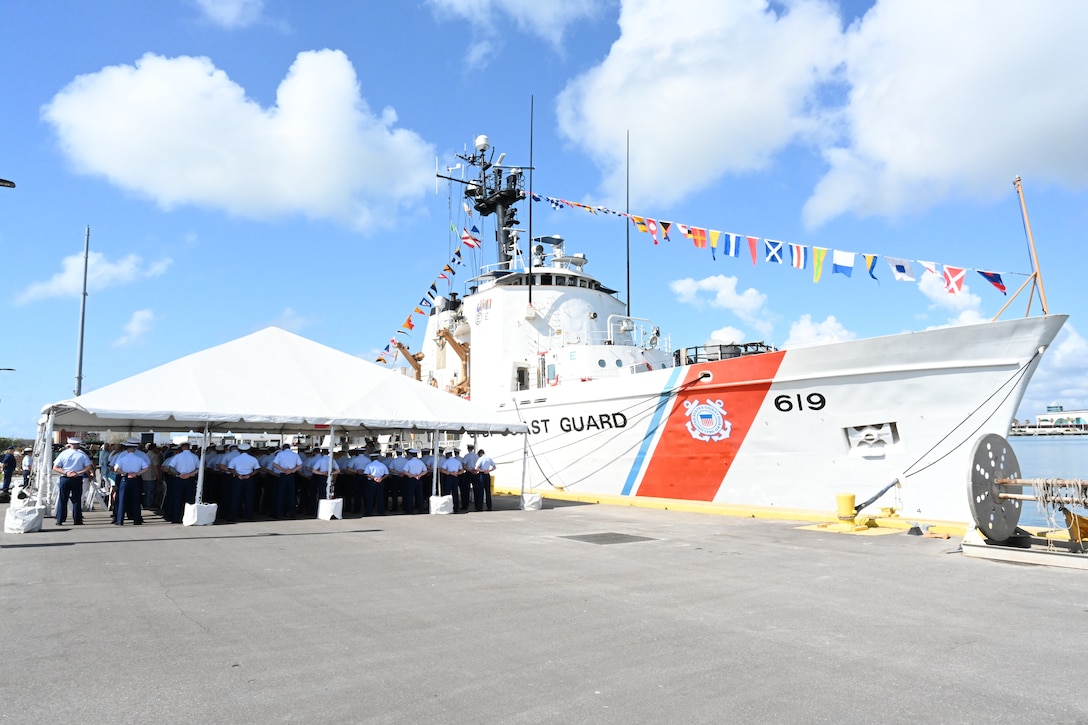
U.S. Coast Guard Cutters Stratton (WMSL 752) and Bailey Barco (WPC 1122) rendezvous in Beaver Inlet near Dutch Harbor, Unalaska, Alaska, Feb. 28, 2024. Both cutters conducted joint cutter boat training and formation steaming while on patrol in the Bering Sea and Gulf of Alaska for fisheries enforcement, safety of life at sea, and sovereignty projection. (U.S. Coast Guard courtesy photo)
Below is a Bollinger Shipyards news release. This is significant because it goes beyond the 65 FRCs that might have been justified by any interpretation of the DEEPWATER based “Program of Record,” which included 58 FRC, to which was added six additional FRCs for PATFORSWA. One FRC was essentially destroyed by a fire in a dockyard. I can only assume the additional two will either augment the three currently in Guam or will go into a new homeport somewhere in the Western Pacific.
As it stands the Coast Guard has ten NSCs, 24 WMECs, and 56 FRCs for a total of 90 vessels. While the number of vessels over 1000 tons full load is down substantially, the total is much the same as the fleet the program of record was intended to replace. Essentially FRCs have replaced not only 49 smaller WPB110s but also some WMECs.
Total displacement for the fleet is up from the fleet being replace. I believe manning requirements are also up and both total displacement and manning requirements will rise considerably as OPCs are commissioned and replace WMECs.
U.S. COAST GUARD AWARDS BOLLINGER SHIPYARDS TWO FAST RESPONSE CUTTERS
LOCKPORT, La., — (May 13, 2024) – The U.S. Coast Guard has exercised a contract option to award Bollinger Shipyards (“Bollinger”) two additional Sentinel-Class Fast Response Cutters (FRC). This announcement brings the total number of FRCs awarded to Bollinger up to 67 vessels since the program’s inception. To date, the U.S. Coast Guard has commissioned 55 FRCs into operational service.
“We’re incredibly proud of our long history supporting the U.S. Coast Guard that now stretches four decades,” said Bollinger Shipyards President and CEO Ben Bordelon. “Our unique experience building for the Coast Guard is unparalleled and has shown time and time again that we can successfully deliver the highest quality and most capable vessels. We look forward to continuing our partnership with the Coast Guard.”
Both FRCs will be built at Bollinger’s Lockport, La. facility that supports over 650 direct jobs in Lafourche Parish out of the nearly 4,000 shipbuilders supporting Bollinger’s 13 facilities across Louisiana and Mississippi.
Bordelon continued, “This program isn’t just an economic benefit for our region, but a national security priority that continues to enjoy the support of a bipartisan, bicameral coalition in the United States Congress. That being said, these additional vessels allow for the continued prosperity and economic wellbeing for over 650 families in South Louisiana. The hardworking men and women of Bollinger Shipyards take tremendous pride in every single vessel we build and deliver for the U.S. government knowing we’re helping to keep our homeland safe.”
The FRC program has had a total economic impact of over $2 billion since its inception in material spending and directly supports more than 650 jobs in Southeast Louisiana. The program has indirectly created 1,690 new jobs from operations and capital investment and has an annual economic impact on GDP of $202 million, according to the most recent data from the U.S. Maritime Administration (MARAD) on the economic importance of the U.S. Shipbuilding and Repair Industry. Bollinger sources over 271,000 different items for the FRC consisting of 282 million components and parts from 965 suppliers in 37 states.
The FRC is one of many U.S. Government shipbuilding programs that Bollinger is proud to support. In addition to the construction of the FRC, Bollinger is contracted to build the Polar Security Cutter (PSC) for the U.S. Coast Guard, the Towing, Salvage and Rescue Ship (T-ATS), the Auxiliary Personnel Lighter (APL), the newest oceanographic survey ship (T-AGS 67) and the Mine Countermeasures Unmanned Surface Vessels (MCM USV) for the U.S. Navy. Bollinger is also building three Regional Class Research Vessels (RCRV) for the National Science Foundation through Oregon State University. Bollinger also supports the nuclear-powered ballistic missile submarine program by building various platforms for General Dynamics-Electric Boat.
ABOUT THE FAST RESPONSE CUTTER PLATFORM
The FRC is an operational “game changer,” according to senior Coast Guard officials. FRCs are consistently being deployed in support of the full range of missions within the United States Coast Guard and other branches of our armed services. This is due to its exceptional performance, expanded operational reach and capabilities, and ability to transform and adapt to the mission. FRCs have conducted operations as far as the Marshall Islands—a 4,400 nautical mile trip from their homeport. Measuring in at 154-feet, FRCs have a flank speed of 28 knots, state of the art C4ISR suite (Command, Control, Communications, Computers, Intelligence, Surveillance, and Reconnaissance), and stern launch and recovery ramp for a 26-foot, over-the-horizon interceptor cutter boat.
ABOUT BOLLINGER SHIPYARDS
Bollinger Shipyards (www.bollingershipyards.com) has a 78-year as a leading designer and builder of high-performance military patrol boats and salvage vessels, research vessels, ocean-going double hull barges, offshore oil field support vessels, tugboats, rigs, lift boats, inland waterways push boats, barges, and other steel and aluminum products from its new construction shipyards as part of the U. S. industrial base. Bollinger has 13 facilities, all strategically located throughout Louisiana and Mississippi with direct access to the Gulf of Mexico, the Mississippi River and the Intracoastal Waterway. Bollinger is the largest vessel repair company in the Gulf of Mexico region.










